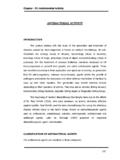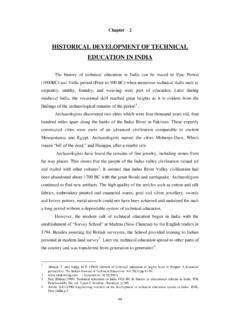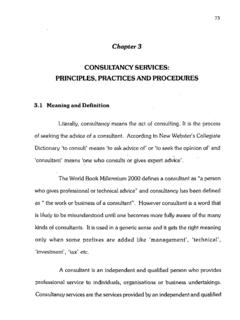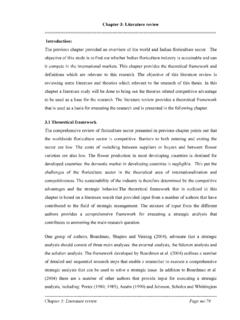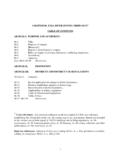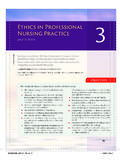Transcription of Full Energy Peak Efficiency Calibration of HPGe …
1 145 chapter -5 full Energy peak Efficiency Calibration of hpge detector by MCNP Introduction Efficiency Calibration : Different methods Monte Carlo method Detector parameters determination Effect of detector parameters on the FEP Efficiency Optimization of detector geometry Objective of the work Gamma spectrometric measurements Monte Carlo Simulation Comparison of MCNP and experimental efficiencies Optimization of different detector parameters Detector crystal geometry Detector end cap thickness and end cap to crystal distance Efficiency transfer to volumetric
2 Sources Conclusion chapter 5 146 Introduction As emphasized in chapter 2, calculation or measurement of full Energy peak (FEP) Efficiency for particular source-detector geometry is essential for quantitative analysis of any radionuclide by gamma ray spectrometry. Efficiencies at a particular gamma ray Energy E is experimentally obtained by using a gamma ray source (emitting photon of Energy E) of known disintegration rate. The Calibration of FEP Efficiency as a function of gamma ray Energy is known as FEP Efficiency Calibration of a gamma ray detector. Since no two detectors can have exactly the same sensitive volume, there efficiencies can never exactly match so that each gamma ray detector has to be individually calibrated for its Efficiency to get reliable results.
3 Efficiency Calibration : Different methods For routine gamma spectrometric analysis, Efficiency Calibration of a gamma ray detector is carried out using a set of standards emitting gamma rays over the Energy range of 50-1500 keV. full Energy peak Efficiency Calibration is preferably done using the monoenergetic gamma ray sources 241Am, 109Cd, 57Co, 139Ce, 203Hg, 51Cr, 113Sn, 85Sr, 137Cs and 65Zn. The gamma ray energies and abundances along with the half-lives of these radionuclides are given in Table However, the availability of monoenergetic primary standards is a constraint. Moreover, some of these sources are not very long lived 203Hg (t1 d), 51Cr (t1 d), so they need to be replaced periodically.
4 chapter 5 147 Table Monoenergetic sources used as Calibration sources. Nuclide Energy (keV) Gamma rayAbundances(%) Half-life 109Cd d 57Co d 139Ce d 203Hg d 51Cr d 113Sn d 85Sr d 137Cs y 65Zn 1115
5 D Multi-gamma ray sources like 152Eu ( y), 133Ba ( y), 110 Agm ( d), 226Ra ( x 103 y) and 56Co ( d) are often preferred for Efficiency Calibration as they cover a wide Energy range and are longer lived. The gamma ray energies of these radionuclides are given in Table However, these sources emit gamma rays in cascade and for close sample-to-detector distances, there may be substantial coincidence summing leading to inaccuracy in Efficiency Calibration . Therefore, standard multi-gamma sources cannot be used for Efficiency Calibration of a detector at close sample-to-detector distance.
6 However, gamma spectrometric analysis of low level samples needs to count the samples chapter 5 148 as close as possible to the detector. These difficulties can be circumvented using Monte Carlo simulation for full Energy peak Efficiency . Table Multi-energetic sources used as Calibration sources. Nuclide Energy (keV) Gamma ray abundance (%) NuclideEnergy (keV) Gamma ray abundance (%) 152Eu 133Ba 81 356 56Co
7 110 Agm 226Ra chapter 5 149 Monte Carlo Method It is a powerful tool to simulate the detector response and is applicable to a variety of sample matrices and geometries [Sima and Arnold (2009), Vidmar et al.]
8 (2008), Tzika et al. (2004), R denas et al. (2003), Ewa et al. (2001)]. The basic principle of this method has been discussed in chapter 1. Monte Carlo methods were first used by Wainio and Knoll (1966) and De Castro Faria and Levesque (1967) for full Energy peak efficiencies calculations. Bronson and Wang (1996) have given an extensive description on the use of the Monte Carlo method for Efficiency determination at various source detector geometries (on and off detector axis), complex source shapes and Marinelli beaker models. General Monte Carlo codes like MCNP [Wang et al. (1994), Kamboj and Kahn (1996), Fehrenbacher et al.
9 (1996), Glouvas et al. (1998), Rodenas et al. (2000)], GEANT [Glouvas et al. (1998), Sanchez et al. (1991), Decombaz et al. (1992), Garcia-Talavera (2000), Korun et al. (1997)], EGS4 [Fehrenbacher et al. (1996)], CYLTRAN [Ludington and Helmer (2000)] are also being tested extensively. These codes are increasingly used to simulate Efficiency for cases where experimental determination is impossible or difficult such as samples of nonstandard geometry and for large sized samples environmental samples [Nakamura and Suzuki (1983)] and waste drums where standards are not easily available. Also, these simulation methods are decay scheme independent and are consequently free of any coincidence summing.
10 Therefore, these methods can be used to obtain FEP Efficiency at closest sample-to-detector distance where multi-gamma ray sources cannot be used. Additionally, these simulation codes can be used to get total Efficiency required for coincidence summing correction. However, as reported in most of the literature, there is often a mismatch between the simulated and experimental chapter 5 150 efficiencies. This is due to the inaccuracy of the detector geometry specifications given by the manufacturer. The dimensions provided by the manufacturer correspond to the time of assembly of the detection system at room temperature. But there can be changes in the mechanical support of the crystal due to contractions at low temperature leading to changes in the detector configuration [Johnston et al.]
